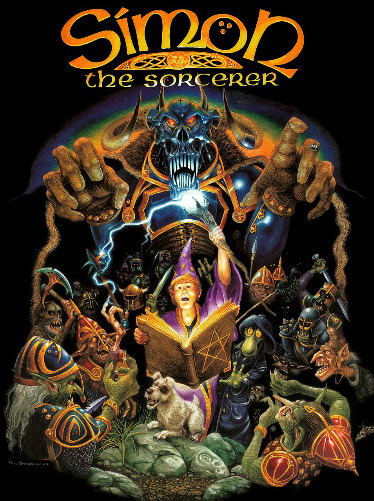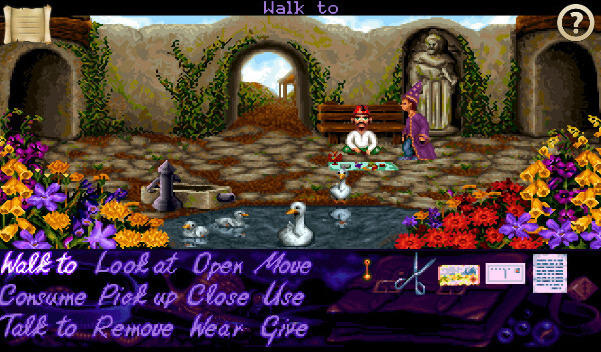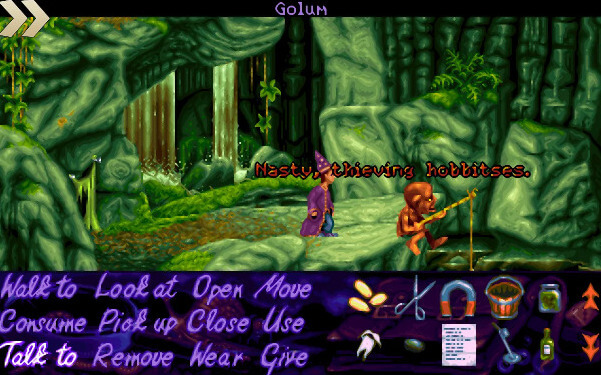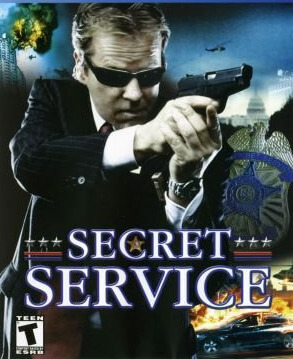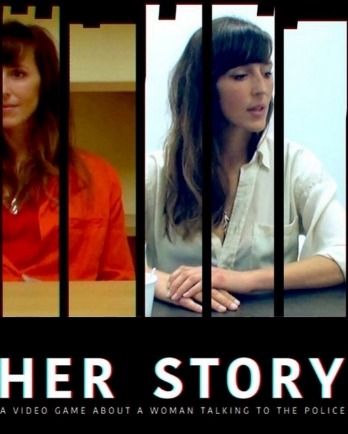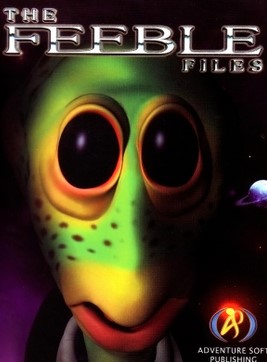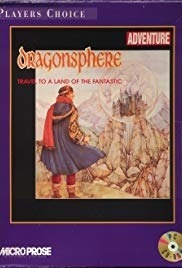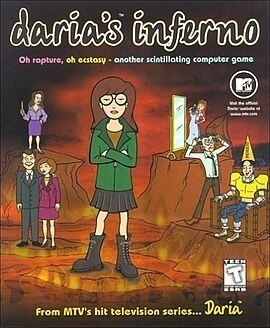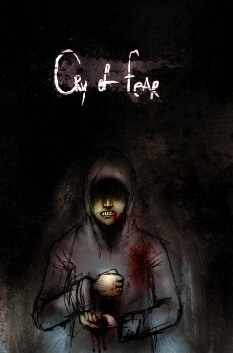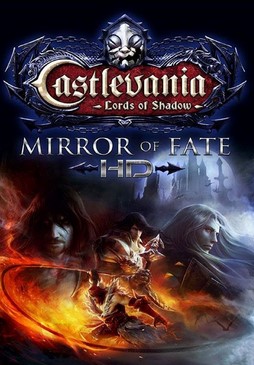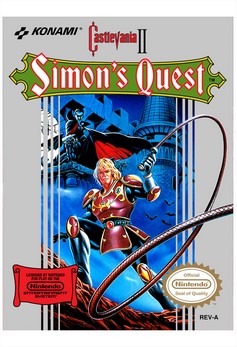Instructed to become a wizard, Simon is told to seek out wizards in the local tavern,. He performs tasks for various people, recovering the spell book he lost, as well as locating Sordid's tower. After, gaining entry, he ends up in the tower's garden. Searching the tower, Simon helps to send some demons back to hell, and uses a teleporter to take him to the Fiery Pits of Rondor, so as to destroy Sordid's wand. Simon defeats him, and is sent back to his world. Although he assumes he had a dream, a portal opens in his bedroom, and a large gloved hand appears, taking him back through it.
Gameplay
As a point-and-click adventure game, the player controls Simon using the mouse. The iOS and Android versions feature touchscreen controls. Gameplay involves moving Simon around and interacting with objects and other characters. The player can make Simon perform actions such as giving an item to another character, talk to another character, and pick up (add to inventory), examine, use, move, consume, wear, or open or close an item. Some actions are binary: they involve two objects and the player sometimes, after telling Simon to use an item, needs to specify what to use it with. A map that enables Simon to instantly transport to a major landmark (if it has been discovered) is provided. The postcard is used to load, save, or quit the game.
The game includes parodies of various popular books and fairy tales, including Rapunzel, The Lord of the Rings, Discworld, The Chronicles of Narnia, Jack and the Beanstalk, and the Three Billy Goats Gruff.
Reception
Simon the Sorcerer received critical acclaim: across all platforms, the humour and visuals in particular were commended, although criticisms included the controls and the game's linear nature. The game's global sales surpassed 600,000 units by September 1999.
The Amiga version received generally high ratings. CU Amiga praised the high quality graphics and how much fun the game was to play. Amiga Computing's Simon Clays also praised the graphics and the locations, saying the locations' stylisation made the game resemble a fairy tale. He also enjoyed the puzzles and detail in the game. The One's reviewer said the graphics are "excellent", but believed the music did not take full advantage of the Amiga's sound hardware. A reviewer of Génération 4 thought the Amiga version's graphics are "magnificent".
The CD32 version was noted for its speech. CU Amiga's Dean Evans was impressed with "sumptuous" backgrounds and the animation, and believed the main selling point was the digitised speech, especially Chris Barrie as Simon. Jonathan Nash of Amiga Power liked the "gorgeous" graphics, but thought the dialogue was annoying, and he also criticised the puzzles as "spread thinly over the pointlessly large playing area". The reviewer of Amiga CD32 Gamer was impressed with the soundtrack, describing it as "top notch", and thought the story had plenty of wit. The main criticism was the scenes downplaying interaction, making the comedy linear. The One's reviewer corroborated others' views on the graphics, believing them to be "stunning", and also believed the atmosphere was augmented by the speech. Chris Barrie as Simon was believed by Amiga Computing to "greatly enhance" the game by giving the speech a new appeal. Amiga Format's reviewer criticised the controls, believing the controller's limitations would make players "an insane hysterical gibbering wreck", but complimented the addition of speech, and echoed others' opinions on the graphics by calling them "beautiful". In a later review, Andy Smith believed that Barrie's voice acting livened the humour, and concurred with Evans' evaluation of the graphics as "sumptuous", but said that it was difficult to get the game working on an Amiga 1200.
Reviewers of the DOS and Windows versions praised the humour and dialogue. The reviewers of Génération 4 described the adventure as "excellent", and believed Simon the Sorcerer might be the most amusing and idiosyncratic adventure game. Computer Gaming World stated that the "wacky, tongue-in-cheek interactive fantasy ... features a rich world of tasty puzzles designed to test the wits of the most astute adventurer while keeping the humor dial turned up to the max". Jeuxvideo.com described the characters' dialogue as "crazy" and praised the abundance of humour, but they believed the adventure is over too quickly. Their review of the Amiga version was identical. Tawny Ditmer of Gamezebo lauded the story as "hilarious" and the scenery and music as "wonderfully colorful and cheery", criticised the lack of side-quests and pointed out that the original graphics looks outdated in 2009. The script and dialogue were praised as "fantastic" by Rob Franklin of Adventure Gamers, and complimented Chris Barrie's "brilliant" voice acting, but criticised the plot for being vague. He recommended the game for fans of adventure games and British humour. Zoltán Ormándi of Adventure Classic Gaming thought highly or the puzzles' originality and Simon's humour. He claimed that the game's popularity caused a term, "Simonology" to be coined describing the humour of an adventure's protagonist. GameRankings states the PC version has a rating of 86 per cent. The reviewer of Joystick liked the decoration, animation, and characters.
Paul Marchant of Pocket Gamer reviewed the iOS version, and said that it was the game he liked, rather than the iPhone implementation, but thought the game a "classic" and described the dialogue as "original". Damian Chiappara of AppSpy believed the iOS version's graphics are improved over the original, and liked the "quirky" humour, but thought that it can take time for players to familiarise themselves with its controls. The iPad and Android versions appeared on Pocket Gamer's Top 10 point-and-click adventure games for their respective platforms.
In 2011, Adventure Gamers named Simon the Sorcerer the 44th-best adventure game ever released.
